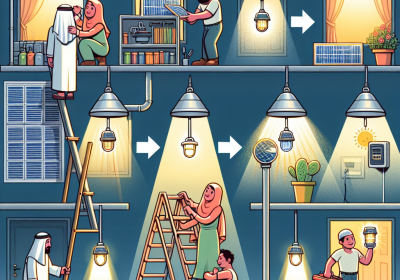Temporary Solar Lighting for Construction Sites
-
Table of Contents
Temporary solar lighting for construction sites is an innovative solution that leverages renewable energy to provide illumination in areas where traditional power sources may be unavailable or impractical. These systems typically consist of solar panels, rechargeable batteries, and energy-efficient LED lights, designed to withstand the rigors of construction environments. By harnessing solar energy, these lighting solutions offer a sustainable and cost-effective alternative to diesel generators or grid electricity, reducing carbon emissions and operational costs. Additionally, temporary solar lighting is easy to install and relocate, making it an ideal choice for dynamic construction projects that require flexible and reliable lighting options.
Benefits Of Temporary Solar Lighting For Construction Sites
Temporary solar lighting for construction sites offers a multitude of benefits that extend beyond mere illumination. As construction projects often operate around the clock, ensuring adequate lighting is crucial for maintaining productivity and safety. Solar lighting solutions provide an efficient and environmentally friendly alternative to traditional lighting methods, which rely heavily on fossil fuels and the electrical grid.
One of the primary advantages of temporary solar lighting is its sustainability. Solar lights harness energy from the sun, a renewable resource, thereby reducing the carbon footprint associated with construction activities. This is particularly important in an era where environmental regulations are becoming increasingly stringent, and companies are under pressure to adopt greener practices. By utilizing solar lighting, construction firms can demonstrate their commitment to sustainability, which can enhance their reputation and potentially attract more business.
In addition to environmental benefits, solar lighting systems are cost-effective. Traditional lighting solutions often incur significant expenses related to fuel consumption, electricity bills, and maintenance. Solar lights, on the other hand, require minimal maintenance and have no ongoing fuel costs. The initial investment in solar lighting equipment is quickly offset by the savings accrued over time. Furthermore, many regions offer incentives and rebates for adopting renewable energy technologies, which can further reduce the financial burden on construction companies.
Another significant benefit of temporary solar lighting is its ease of installation and mobility. Construction sites are dynamic environments where the layout and requirements can change rapidly. Solar lighting units are typically designed to be portable and easy to set up, allowing for quick adjustments as the project progresses. This flexibility ensures that all areas of the site are adequately illuminated, enhancing both safety and efficiency. Workers can perform their tasks with greater accuracy and confidence, reducing the likelihood of accidents and errors.
Safety is a paramount concern on construction sites, and adequate lighting plays a crucial role in mitigating risks. Poorly lit areas can lead to accidents, injuries, and even fatalities. Solar lighting provides consistent and reliable illumination, ensuring that all parts of the site are visible and safe for workers. This is particularly important during night shifts or in areas with limited natural light. Enhanced visibility also aids in the security of the site, deterring theft and vandalism, which are common issues in construction zones.
Moreover, solar lighting systems are highly reliable and resilient. They are designed to withstand harsh weather conditions, making them suitable for use in various environments. Unlike traditional lighting, which can be affected by power outages or fuel shortages, solar lights continue to operate as long as there is sunlight to charge their batteries. This reliability ensures that construction activities can proceed uninterrupted, regardless of external factors.
In conclusion, temporary solar lighting for construction sites offers numerous benefits that make it an attractive option for modern construction projects. Its sustainability, cost-effectiveness, ease of installation, and contribution to safety and security are compelling reasons for construction firms to consider adopting this technology. As the industry continues to evolve, embracing innovative solutions like solar lighting will be essential for meeting the demands of efficiency, safety, and environmental responsibility.
How To Install Temporary Solar Lighting On Construction Sites

Installing temporary solar lighting on construction sites is a practical and environmentally friendly solution that enhances safety and efficiency. The process involves several key steps, each of which must be carefully executed to ensure optimal performance and longevity of the lighting system. By following a systematic approach, construction managers can effectively implement solar lighting, thereby reducing reliance on traditional power sources and minimizing the environmental footprint of their projects.
To begin with, it is essential to conduct a thorough site assessment. This involves evaluating the specific lighting needs of the construction site, including identifying areas that require illumination for safety and operational purposes. During this assessment, it is crucial to consider factors such as the size of the site, the duration of the project, and the typical working hours. Additionally, understanding the local climate and weather patterns can help in selecting the most suitable solar lighting equipment.
Once the site assessment is complete, the next step is to select the appropriate solar lighting fixtures. There are various types of solar lights available, including floodlights, streetlights, and portable lights. Each type serves different purposes and offers varying levels of brightness and coverage. It is important to choose fixtures that are durable and designed to withstand the harsh conditions often encountered on construction sites. Moreover, selecting lights with adjustable settings can provide flexibility in meeting the changing needs of the project.
After selecting the fixtures, the installation process can commence. The first task is to position the solar panels in locations that receive maximum sunlight exposure throughout the day. This is critical for ensuring that the panels can generate sufficient energy to power the lights during nighttime operations. It is advisable to mount the panels at an angle that optimizes sunlight absorption and to avoid placing them in shaded areas. Secure mounting is essential to prevent damage from wind or other environmental factors.
Following the installation of the solar panels, the next step is to connect them to the lighting fixtures. This typically involves running wiring from the panels to the lights, ensuring that all connections are secure and weatherproof. It is important to follow the manufacturerŌĆÖs instructions and adhere to any relevant electrical codes and standards. In some cases, it may be necessary to install a battery storage system to store excess energy generated during the day for use at night. This can be particularly beneficial in regions with variable weather conditions.
Once the wiring and connections are complete, it is time to test the system. This involves checking that the lights turn on and off as expected and that they provide adequate illumination for the designated areas. It is also important to monitor the performance of the solar panels and batteries to ensure they are functioning correctly. Regular maintenance, such as cleaning the panels and checking for any damage, can help to maintain the efficiency and longevity of the system.
In conclusion, installing temporary solar lighting on construction sites is a multi-step process that requires careful planning and execution. By conducting a thorough site assessment, selecting appropriate fixtures, positioning solar panels for optimal sunlight exposure, and ensuring secure connections, construction managers can successfully implement solar lighting solutions. This not only enhances safety and efficiency on the site but also contributes to environmental sustainability by reducing reliance on traditional power sources. Regular maintenance and monitoring are essential to ensure the continued performance of the system, making solar lighting a viable and beneficial option for construction projects.
Cost-Effectiveness Of Temporary Solar Lighting Solutions For Construction Projects
Temporary solar lighting solutions have emerged as a cost-effective alternative for construction projects, offering numerous financial and operational benefits. As construction sites often require extensive lighting to ensure safety and productivity, traditional lighting methods can be both expensive and environmentally taxing. In contrast, solar lighting systems harness renewable energy from the sun, significantly reducing operational costs and environmental impact.
One of the primary advantages of temporary solar lighting is the reduction in energy expenses. Traditional lighting systems rely on electricity from the grid, which can be costly, especially for large-scale construction projects that operate around the clock. Solar lighting systems, however, utilize photovoltaic panels to capture and convert sunlight into electrical energy, which is then stored in batteries for use during nighttime or cloudy conditions. This self-sustaining energy source eliminates the need for continuous electricity consumption from the grid, leading to substantial savings on utility bills.
Moreover, the installation and maintenance costs associated with temporary solar lighting are generally lower than those of conventional lighting systems. Traditional lighting often requires extensive wiring and infrastructure, which can be both time-consuming and expensive to install. In contrast, solar lighting units are typically designed for easy deployment, with minimal wiring and infrastructure needed. This ease of installation not only reduces labor costs but also minimizes downtime, allowing construction projects to proceed without significant interruptions.
In addition to cost savings, temporary solar lighting solutions offer enhanced flexibility and mobility. Construction sites are dynamic environments, with lighting needs that can change frequently as the project progresses. Solar lighting units are portable and can be easily relocated to different areas of the site as needed, without the constraints of fixed wiring systems. This adaptability ensures that optimal lighting conditions are maintained throughout the project, enhancing both safety and efficiency.
Furthermore, the use of solar lighting aligns with growing environmental and sustainability goals. Construction projects are increasingly being scrutinized for their environmental impact, and adopting renewable energy solutions can significantly improve a project’s sustainability profile. Solar lighting systems produce zero emissions during operation, reducing the carbon footprint of the construction site. Additionally, the use of renewable energy sources can contribute to achieving green building certifications and meeting regulatory requirements, which can be advantageous for both contractors and developers.
Another important consideration is the reliability and durability of solar lighting systems. Modern solar lighting units are designed to withstand harsh environmental conditions, including extreme temperatures, heavy rain, and strong winds. This robustness ensures that the lighting remains operational even in challenging weather, providing consistent illumination and enhancing site safety. Additionally, advancements in battery technology have improved the storage capacity and lifespan of solar lighting systems, ensuring reliable performance over extended periods.
While the initial investment in solar lighting systems may be higher compared to traditional lighting, the long-term cost savings and operational benefits make it a financially prudent choice. The reduction in energy expenses, lower installation and maintenance costs, and enhanced flexibility contribute to a favorable return on investment. Moreover, the environmental benefits and alignment with sustainability goals further enhance the value proposition of temporary solar lighting solutions for construction projects.
In conclusion, temporary solar lighting offers a cost-effective and sustainable alternative for construction sites, providing significant financial savings, operational efficiency, and environmental benefits. As the construction industry continues to evolve, the adoption of renewable energy solutions like solar lighting will play a crucial role in promoting sustainable development and reducing the environmental impact of construction activities.
┬Ā
Read more about Temporary Solar Lighting
- Introduction to Temporary Solar Lighting
- Advantages of Temporary Solar Lighting
- Temporary Solar Lighting for Events and Festivals
- Temporary Solar Lighting for Outdoor Recreation
- Temporary Solar Lighting for Disaster Relief
- Temporary Solar Lighting for Parking Lots and Garages
- Temporary Solar Lighting for Road and Highway Construction
- Temporary Solar Lighting for Military and Security Operations
- Choosing, Installing, and Maintaining Temporary Solar Lighting









